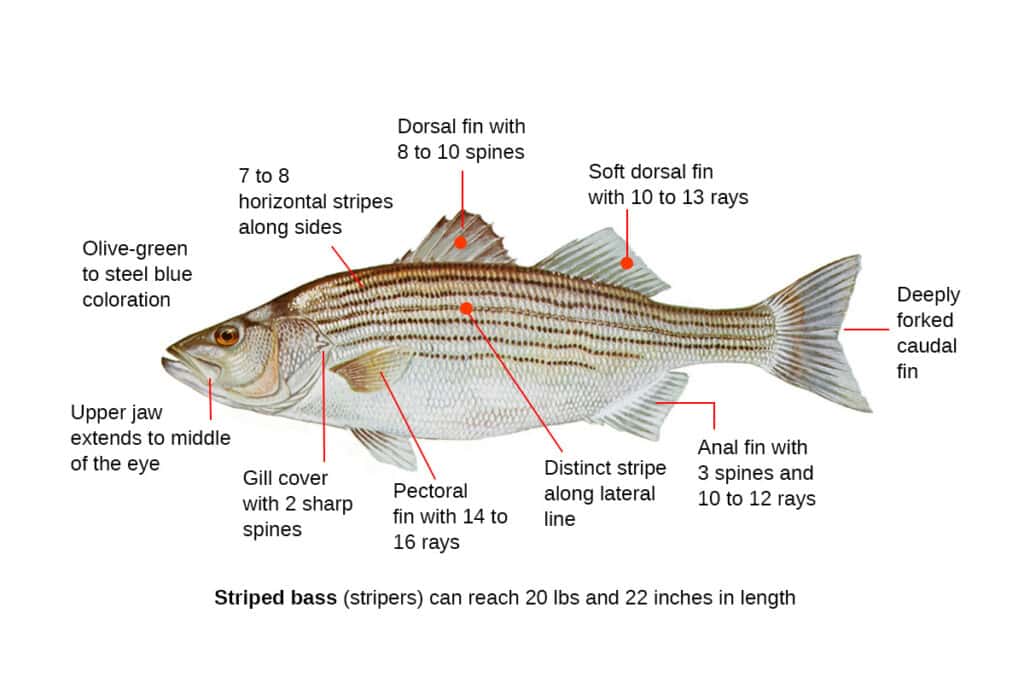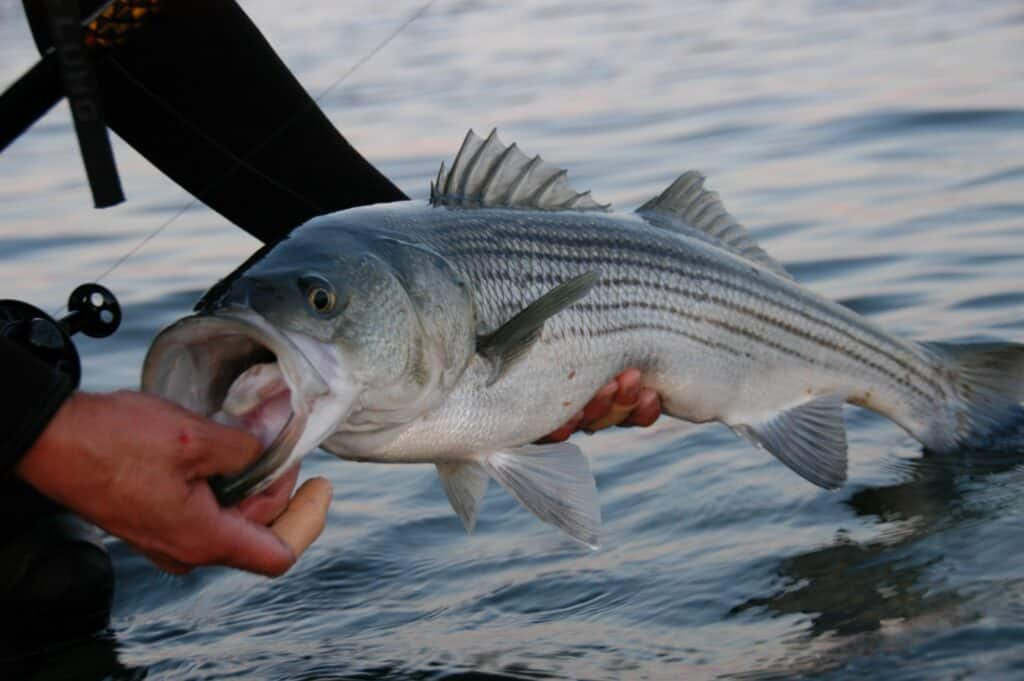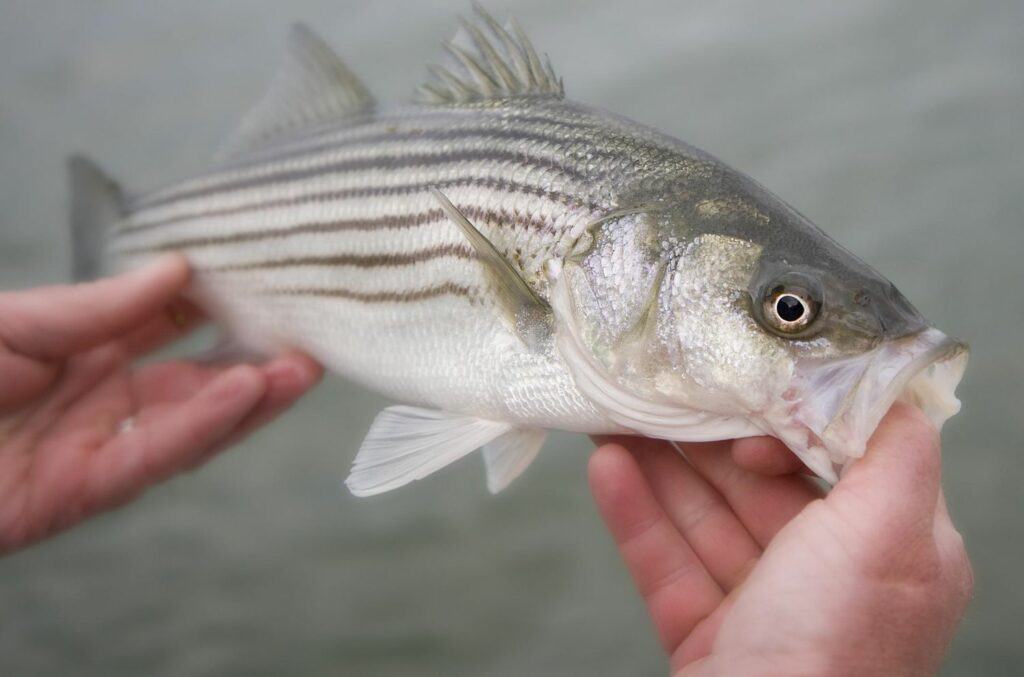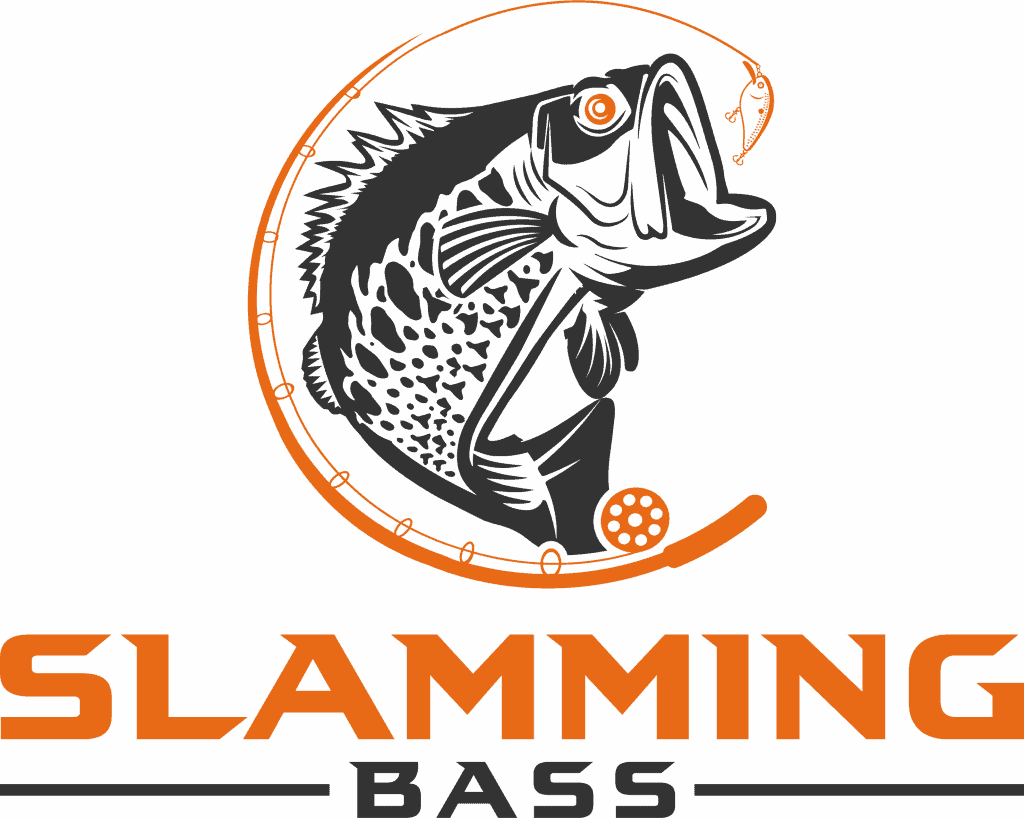Striped bass, scientifically known as Morone saxatilis, holds a unique position within the bass species family, captivating anglers and marine biologists alike with its distinct features and behaviors. This article aims to provide a comprehensive examination of the striped bass, focusing on its unique characteristics, habitat preferences, and distribution across North America. Along with fishing tips on how to target striped bass effectively.

The Distinctive Biology of Striped Bass
Physical Characteristics
The striped bass is easily recognizable by its high, arching back, silvery body, and, most notably, the dark horizontal stripes running from the gills to the base of the tail. These stripes serve as a key identifier among its species. Adult striped bass can grow to significant sizes, with individuals reaching lengths of up to 5 feet and weights exceeding 60 pounds, although sizes vary significantly across different regions and habitats.

Reproductive Habits
The reproductive habits of the striped bass are another aspect that sets it apart within the bass family. Unlike many freshwater species, striped bass spawn in brackish waters. The females can lay up to 3 million eggs, which are fertilized externally in the water by males. This spawning process typically occurs in spring, when water temperatures reach between 59 to 69 degrees Fahrenheit, and plays a crucial role in the survival and distribution of the species.
The Habitat and Range of Striped Bass
Striped bass are versatile creatures that can thrive in both freshwater and saltwater environments, a trait known as anadromy. Originally native to the Atlantic coastline of North America, from Canada to Florida, and the Gulf of Mexico, the species has been successfully introduced to various other freshwater and marine habitats across the continent.
Native and Introduced Habitats
In their native range, striped bass are commonly found in estuaries and rivers where they spawn, as well as along coastal waters where they migrate seasonally. The Chesapeake Bay, Delaware River, and Hudson River are notable for their significant striped bass populations. Through human intervention, striped bass have been introduced to inland waters across the United States, including lakes, reservoirs, and river systems far from their natural marine environments.
Regional Highlights: Striped Bass Across North America
Despite its wide distribution, the striped bass exhibits regional variations in behavior, size, and population dynamics. In the Northeast, particularly in areas like the Chesapeake Bay and Hudson River, striped bass are a cornerstone of recreational fishing and local economies. The West Coast, particularly California, has seen a successful introduction of the species into the San Francisco Bay and Sacramento-San Joaquin River system, creating new angling opportunities and ecological interactions.
Targeting Striped Bass: Best Lures and Techniques
Anglers seeking the thrill of catching striped bass need to arm themselves with not only the right lures but also the mastery of techniques specific to this elusive species. Striped bass are known for their wariness and strength, making them a challenging but rewarding target. This section delves into the most effective lures and fishing techniques that have been proven to entice striped bass, enhancing your angling experience and success rate.
Understanding Striped Bass Behavior
Before diving into the lures and techniques, it’s crucial to understand the behavior of striped bass. They are opportunistic feeders, preying on a wide range of baitfish such as herring, shad, and menhaden, as well as crustaceans and smaller fish species. Their feeding habits change with the seasons, water temperatures, and available prey, making flexibility and knowledge key in targeting them successfully.

Top Lures for Striped Bass
Soft Plastic Lures: Soft plastic swimbaits and shads mimic the movement and appearance of the striped bass’s natural prey. Opt for lures in sizes that match the local baitfish. Colors should contrast with the water conditions; use darker lures in murky water and lighter, more reflective lures in clear conditions.
Topwater Lures: For an exhilarating fishing experience, topwater lures such as poppers and walk-the-dog style lures are highly effective at dawn and dusk when striped bass are actively feeding on the surface. These lures create surface disturbance and noise that attract aggressive strikes.
Spoons and Spinners: Metal spoons and spinnerbaits can be excellent choices for covering a lot of water and attracting bass with their flashy, reflective properties. They work well in both shallow and deep waters, depending on how they’re retrieved.
Jigs: Bucktail jigs, often tipped with a piece of cut bait or a soft plastic tail, are versatile and can be jigged off the bottom or used to imitate injured baitfish with a jerky, vertical motion.
Effective Techniques for Striped Bass Fishing
Trolling: Trolling allows anglers to cover large areas of water, using multiple rods to present lures at different depths. It’s especially effective in locating schools of striped bass in larger bodies of water.
Casting and Retrieving: Casting towards structures such as rock piles, weed beds, or drop-offs and retrieving the lure with varying speeds can mimic injured prey and trigger strikes. Pay attention to the time of day and the level of light, as these factors influence striped bass activity.
Live Lining: Using live bait, such as small fish or eels, and allowing them to swim freely can be irresistible to striped bass. This technique requires patience and a sensitive touch to detect subtle bites.
Drift Fishing: When targeting striped bass in rivers or tidal currents, drift fishing with live bait or cut bait can be highly effective. This natural presentation appeals to the bass’s instincts and can provoke aggressive feeding behavior.
Night Fishing: Striped bass are nocturnal feeders, making night fishing with glow-in-the-dark lures or bait an exciting strategy. Focus on areas with ambient light sources, such as docks or piers, which attract baitfish and, in turn, striped bass.
Striped Bass Everything You Could Ask For
The expansion of the striped bass across North American waters presents both challenges and opportunities. While the species has adapted well to various environments, concerns about competition with native species, potential overfishing, and environmental changes continue to necessitate careful management and research.

Targeting striped bass demands a blend of the right lures and adaptable techniques. By understanding the behavior of striped bass and experimenting with different approaches, anglers can increase their chances of a successful catch. Remember, the conditions and the bass’s feeding patterns dictate the best strategy, so stay observant, be versatile, and enjoy the challenge that comes with pursuing one of North America’s most popular game fish.
Striped bass stands out among its peers in the bass family due to its distinctive physical features, reproductive habits, and adaptability to diverse habitats. Its presence across North America highlights the species’ ecological significance and the importance of ongoing conservation efforts. By understanding and appreciating the unique world of the striped bass, we can ensure its continued role in our waterways and cultures for generations to come.

